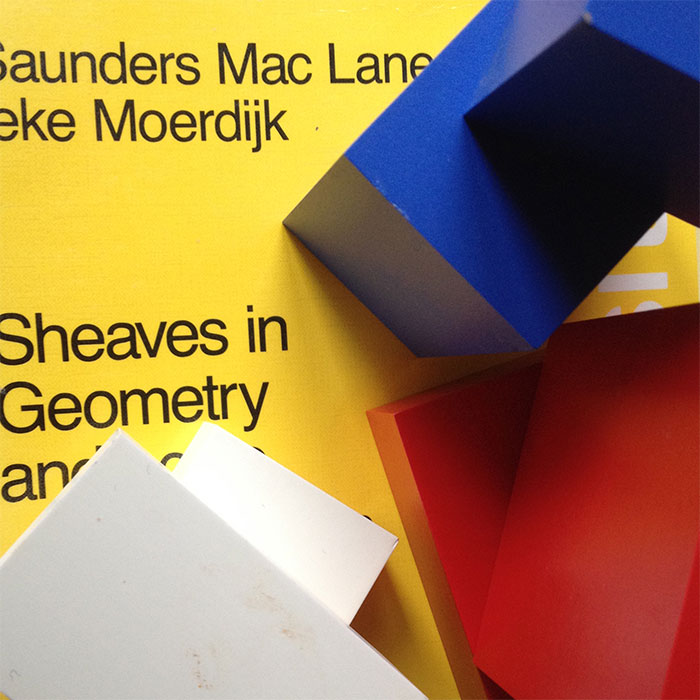Absolute geometry is the attempt to develop algebraic geometry over the elusive field with one element $\mathbb{F}_1$. The idea being that the set of all prime numbers is just too large for $\mathbf{Spec}(\mathbb{Z})$ to be a terminal object (as it is in the category of schemes).
So, one wants to view $\mathbf{Spec}(\mathbb{Z})$ as a geometric object over something ‘deeper’, the “absolute point” $\mathbf{Spec}(\mathbb{F}_1)$.
Starting with the paper by Bertrand Toen and Michel Vaquie, Under $\mathbf{Spec}(\mathbb{Z})$, topos theory entered this topic.
First there was the proposal by Jim Borger to view $\lambda$-rings as $\mathbb{F}_1$-algebras. More recently, Alain Connes and Katia Consani introduced the arithmetic site.
Now, there are lectures series on these two approaches, one by Yuri I. Manin, the other by Alain Connes.
.
Yuri I. Manin in Ghent
On Tuesday, February 3rd, Yuri I. Manin will give the inaugural lectures of the new $\mathbb{F}_1$-seminars at Ghent University, organised by Koen Thas.
Coffee will be served from 13.00 till 14.00 at the Department of Mathematics, Ghent University, Krijgslaan 281, Building S22 and from 14.00 till 16.30 there will be lectures in the Emmy Noether lecture room, Building S25:
14:00 – 14:25: Introduction (by K. Thas)
14:30 – 15:20: Lecture 1 (by Yu. I. Manin)
15:30 – 16:20: Lecture 2 (by Yu. I. Manin)
Recent work of Manin related to $\mathbb{F}_1$ includes:
– Local zeta factors and geometries under $\mathbf{Spec}(\mathbb{Z})$
Alain Connes on the Arithmetic Site
Until the beginning of march, Alain Connes will lecture every thursday afternoon from 14.00 till 17.30, in Salle 5 – Marcelin Berthelot at he College de France on The Arithmetic Site (hat tip Isar Stubbe).
Here’s a two minute excerpt, from a longer interview with Connes, on the arithmetic site, together with an attempt to provide subtitles:
——————————————————
(50.36)
And,in this example, we saw the wonderful notion of a topos, developed by Grothendieck.
It was sufficient for me to open SGA4, a book written at the beginning of the 60ties or the late fifties.
It was sufficient for me to open SGA4 to see that all the things that I needed were there, say, how to construct a cohomology on this site, how to develop things, how to see that the category of sheaves of Abelian groups is an Abelian category, having sufficient injective objects, and so on … all those things were there.
This is really remarkable, because what does it mean?
It means that the average mathematician says: “topos = a generalised topological space and I will never need to use such things. Well, there is the etale cohomology and I can use it to make sense of simply connected spaces and, bon, there’s the chrystaline cohomology, which is already a bit more complicated, but I will never need it, so I can safely ignore it.”
And (s)he puts the notion of a topos in a certain category of things which are generalisations of things, developed only to be generalisations…
But in fact, reality is completely different!
In our work with Katia Consani we saw not only that there is this epicyclic topos, but in fact, this epicyclic topos lies over a site, which we call the arithmetic site, which itself is of a delirious simplicity.
It relies only on the natural numbers, viewed multiplicatively.
That is, one takes a small category consisting of just one object, having this monoid as its endomorphisms, and one considers the corresponding topos.
This appears well … infantile, but nevertheless, this object conceils many wonderful things.
And we would have never discovered those things, if we hadn’t had the general notion of what a topos is, of what a point of a topos is, in terms of flat functors, etc. etc.
(52.27)
——————————————————-
I will try to report here on Manin’s lectures in Ghent. If someone is able to attend Connes’ lectures in Paris, I’d love to receive updates!
Leave a Comment
